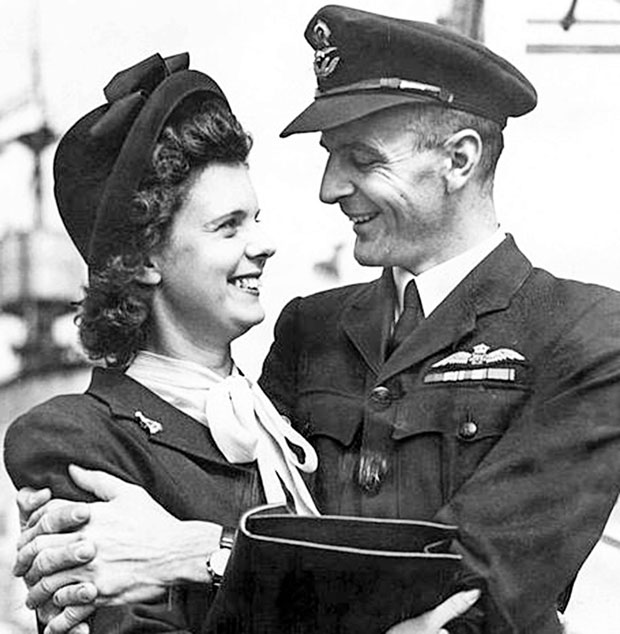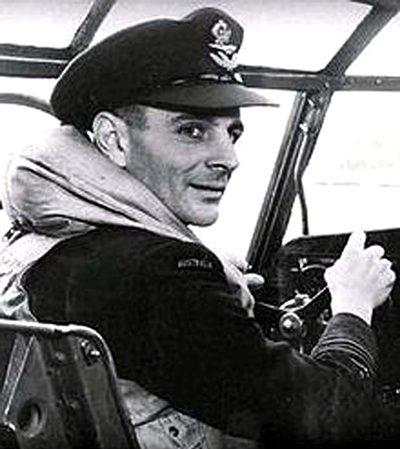THE DRAMATIC finish to the 2019 ICC World Championship propelled cricket into the media spotlight — followed by the Ashes, the no-holds barred Test match series between England and Australia.
There is a link between Helensburgh and Australian cricket, former Aussie skipper Stan Sismey, who found his bride-to-be in Helensburgh when serving with the Marine Aircraft Experimental Establishment during World War Two.

Stan, who died ten years ago, served as a test pilot at RAF Helensburgh, and it was from the MAEE HQ in Rhu that he left to lead the Australian Services XI during the Victory Test Series in 1945, the year he married WAAF Sergeant Elma Fowlie Maclachlan, of Greenknowe, 8 West Argyle Street.
A famous Australian cricketer before, during and after the war, Stanley George Sismey was born on July 15 1916 in Junee, New South Wales, and attended Goulburn High School 120 miles from Sydney.
After training as a banker he joined the Royal Australian Air Force in 1941 and was trained as a pilot in Australia and Canada, reaching the rank of Squadron Leader.
He was co-pilot of a Catalina Flying boat shot down over the Mediterranean by a Vichy French fighter on May 18 1942.
The Catalina crew survived afloat for eight hours despite a secondary attack before being eventually rescued by a British destroyer, but Stan was badly injured during the encounter.
He needed a long convalescent period, and he was then judged not fit for operational duties. He was posted to RAF Helensburgh as a test pilot.
His experience in flying boats was deemed by MAEE to be a great asset, and he had a considerable reputation as an international cricketer and brave war — his survival exploits having appeared in newspapers in Britain and Australia.
He started to appear in flying logs at RAF Helensburgh during the summer of 1943, a year after being shot down, and at that time his rank was recorded as pilot officer.
He was tasked with flying Catalina FP258/G, with G standing for ‘guard this aircraft at all times’.
The Catalina was used to test the most secret prototype MAD device, a magnetic aircraft detector to find enemy submarines. He also flew from Wig Bay to Helensburgh with the first of a few lend-leasers, a Martiner Mariner, to be appraised by MAEE.
He tested various lend lease Consolidated Catalinas and Sunderland flying boats at Helensburgh.
At the same time he found true love with local girl Elma MacLachlan, a sergeant with the WAAF, whose parents ran the family bakery and restaurant business in Sinclair Street, West Clyde Street, and at Roslyn Place, Garelochhead.
The romance blossomed, and on July 15 1945, with the end of war in sight, they married. The best man was team-mate and fellow pilot Flight Lieutenant Keith Carmody, a member of the Services Cricket X1 playing military teams in moral boosting matches.
on July 15 1945, with the end of war in sight, they married. The best man was team-mate and fellow pilot Flight Lieutenant Keith Carmody, a member of the Services Cricket X1 playing military teams in moral boosting matches.
Stan’s younger brother Francis was a wartime fatality before the wedding. He served as a bomber pilot with the RAAF in Australia conducted bombing raids on the Japanese.
On May 20 less than two months before the wedding, he took off in a Liberator bomber from Truscott Airfield in Western Australia. When the aircraft was only feet above the ground it stalled and crashed.
Its load of depth charges exploded. All aboard the Liberator perished because rescuers could not get close to the burning wreckage. Wreckage of the aircraft in which Francis died remained on scrubland near the airfield for decades. It is not known if Stan and Elma knew of the tragedy at their wedding, but If they did, they put on brave smiling faces.
After attending the ceremony at a Dumbarton church, his team-mates played a Scotland XI in Glasgow.
When the war was over he was transferred to RAAF Overseas HQ to organise the Services XI, and was discharged from the RAAF on July 24 1946.
The Services XI was officially a military unit commanded by him, but the on-field captain for the Victory Series was pre-war test cricketer Lindsay Hassett, with Stan as wicket keeper.
He travelled back to Australia with the side in 1945-46 via India and Sri Lanka to resume his first-class career, but Elma, now demobbed from the WAAFs, remained in Helensburgh.
She wanted to join Stan in Australia after his cricket tour and set up home, but it was not a simple matter.
Elma became a successful women’s rights campaigner. She helped bring young families together for a new life Down Under after the war.
Her success reunited loved ones separated by war and peace. However, her efforts are not generally known even in her home town. Like a wartime generation of women her story was secondary to that of her husband, the decorated war hero.
She campaigned for a Government passage scheme to Australia for war brides and children, while Stan made similar efforts in Australia. She was successful, and in 1946 war brides were boarding ships for Britain for Australia, America and Canada.
Elma was among them — and she arrived at Sydney docks on June 3 1946 aboard the aircraft carrier Indefatigable to be greeted by Stan and flashing Press bulbs (top picture).
After they settled into their new home Stan returned to Scotland for a while on tour. On some occasions he had to leave the field of play because the wound war shrapnel moved around his body causing much pain.
Although his cricket career was interrupted by the war, he played 35 first class matches between 1938 and 1952, mostly for New South Wales. He took 88 catches, made 18 stumpings, and as a right-hand batsman had an average of 17.7.
According to an obituary in the Sydney Morning Herald after his death at Taree on June 19 2009 at the age of 92, he was unusual among wicket keepers in that he did not break any of his fingers during his career.
A banker by profession, he returned to work in Scotland in 1952, and played for Clydesdale Cricket Club in Pollokshields. He also had one game for Scotland that year against Yorkshire at Hamilton Crescent in Glasgow.
On his return to Australia he was on the board of selectors for New South Wales from 1958-79, serving ten seasons as chairman. He often attended meetings with his great friend and national selector the legendary Don Bradman.
Later he was chairman of the NSW Cricket Association for a decade, and subsequently was made a life member.
By the time he retired he was a senior manager with the Bank of New South Wales. He was awarded the Medal of the Order of Australia in 1990 for services to cricket, and the Australian Sports Medal in 2000 for his 20 years of voluntary service as a selector.
He was survived by Elma and their two daughters, Pam and Carol. They were married for 54 years.

Her brother David (right), who ran the family business for many years, was a founder member and the second president of Helensburgh Rotary Club. He served as president of the Scottish Bakers from 1961-62.
class career — and also to lead a campaign for the Australian Government to bring war brides over from the UK.
 The campaign was successful and Elma arrived with other war brides aboard the aircraft carrier Indefatigable. Later the couple had two daughters, Pam and Carol.
The campaign was successful and Elma arrived with other war brides aboard the aircraft carrier Indefatigable. Later the couple had two daughters, Pam and Carol.
Although his cricket career was interrupted by the war, he played 35 first class matches between 1938 and 1952, mostly for New South Wales. He took 88 catches, made 18 stumpings, and as a right hand batsman had an average of 17.7.
According to an obituary in the Sydney Morning Herald after his death at Taree on June 19 2009 at the age of 92, he was unusual among wicket keepers in that he did not break any of his fingers during his career.
A banker by profession, he returned to work in Scotland in 1952, and played for Clydesdale Cricket Club in Pollokshields. He also had one game for Scotland that year against Yorkshire at Hamilton Crescent in Glasgow.
On his return to Australia he was on the board of selectors for New South Wales from 1958-79, serving ten seasons as chairman. After that he was chairman of the NSW Cricket Association for a decade, and thereafter was made a life member.
By the time he retired he was a senior manager with the Bank of New South Wales.
He was awarded the Medal of the Order of Australia in 1990 for services to cricket, and the Australian Sports Medal in 2000 for his 20 years of voluntary service as a selector.




